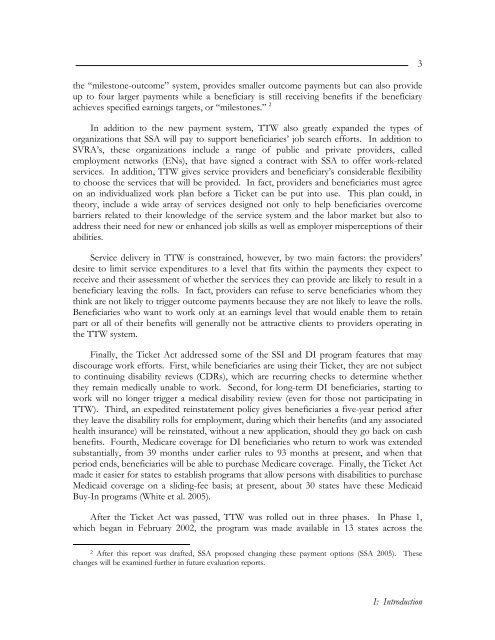Evaluation of the Ticket to Work Program, Implementation ...
Evaluation of the Ticket to Work Program, Implementation ...
Evaluation of the Ticket to Work Program, Implementation ...
You also want an ePaper? Increase the reach of your titles
YUMPU automatically turns print PDFs into web optimized ePapers that Google loves.
<strong>the</strong> “miles<strong>to</strong>ne-outcome” system, provides smaller outcome payments but can also provideup <strong>to</strong> four larger payments while a beneficiary is still receiving benefits if <strong>the</strong> beneficiaryachieves specified earnings targets, or “miles<strong>to</strong>nes.” 2In addition <strong>to</strong> <strong>the</strong> new payment system, TTW also greatly expanded <strong>the</strong> types <strong>of</strong>organizations that SSA will pay <strong>to</strong> support beneficiaries’ job search efforts. In addition <strong>to</strong>SVRA’s, <strong>the</strong>se organizations include a range <strong>of</strong> public and private providers, calledemployment networks (ENs), that have signed a contract with SSA <strong>to</strong> <strong>of</strong>fer work-relatedservices. In addition, TTW gives service providers and beneficiary’s considerable flexibility<strong>to</strong> choose <strong>the</strong> services that will be provided. In fact, providers and beneficiaries must agreeon an individualized work plan before a <strong>Ticket</strong> can be put in<strong>to</strong> use. This plan could, in<strong>the</strong>ory, include a wide array <strong>of</strong> services designed not only <strong>to</strong> help beneficiaries overcomebarriers related <strong>to</strong> <strong>the</strong>ir knowledge <strong>of</strong> <strong>the</strong> service system and <strong>the</strong> labor market but also <strong>to</strong>address <strong>the</strong>ir need for new or enhanced job skills as well as employer misperceptions <strong>of</strong> <strong>the</strong>irabilities.Service delivery in TTW is constrained, however, by two main fac<strong>to</strong>rs: <strong>the</strong> providers’desire <strong>to</strong> limit service expenditures <strong>to</strong> a level that fits within <strong>the</strong> payments <strong>the</strong>y expect <strong>to</strong>receive and <strong>the</strong>ir assessment <strong>of</strong> whe<strong>the</strong>r <strong>the</strong> services <strong>the</strong>y can provide are likely <strong>to</strong> result in abeneficiary leaving <strong>the</strong> rolls. In fact, providers can refuse <strong>to</strong> serve beneficiaries whom <strong>the</strong>ythink are not likely <strong>to</strong> trigger outcome payments because <strong>the</strong>y are not likely <strong>to</strong> leave <strong>the</strong> rolls.Beneficiaries who want <strong>to</strong> work only at an earnings level that would enable <strong>the</strong>m <strong>to</strong> retainpart or all <strong>of</strong> <strong>the</strong>ir benefits will generally not be attractive clients <strong>to</strong> providers operating in<strong>the</strong> TTW system.Finally, <strong>the</strong> <strong>Ticket</strong> Act addressed some <strong>of</strong> <strong>the</strong> SSI and DI program features that maydiscourage work efforts. First, while beneficiaries are using <strong>the</strong>ir <strong>Ticket</strong>, <strong>the</strong>y are not subject<strong>to</strong> continuing disability reviews (CDRs), which are recurring checks <strong>to</strong> determine whe<strong>the</strong>r<strong>the</strong>y remain medically unable <strong>to</strong> work. Second, for long-term DI beneficiaries, starting <strong>to</strong>work will no longer trigger a medical disability review (even for those not participating inTTW). Third, an expedited reinstatement policy gives beneficiaries a five-year period after<strong>the</strong>y leave <strong>the</strong> disability rolls for employment, during which <strong>the</strong>ir benefits (and any associatedhealth insurance) will be reinstated, without a new application, should <strong>the</strong>y go back on cashbenefits. Fourth, Medicare coverage for DI beneficiaries who return <strong>to</strong> work was extendedsubstantially, from 39 months under earlier rules <strong>to</strong> 93 months at present, and when thatperiod ends, beneficiaries will be able <strong>to</strong> purchase Medicare coverage. Finally, <strong>the</strong> <strong>Ticket</strong> Actmade it easier for states <strong>to</strong> establish programs that allow persons with disabilities <strong>to</strong> purchaseMedicaid coverage on a sliding-fee basis; at present, about 30 states have <strong>the</strong>se MedicaidBuy-In programs (White et al. 2005).After <strong>the</strong> <strong>Ticket</strong> Act was passed, TTW was rolled out in three phases. In Phase 1,which began in February 2002, <strong>the</strong> program was made available in 13 states across <strong>the</strong>32 After this report was drafted, SSA proposed changing <strong>the</strong>se payment options (SSA 2005). Thesechanges will be examined fur<strong>the</strong>r in future evaluation reports.I: Introduction
















